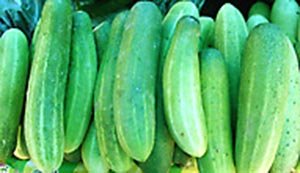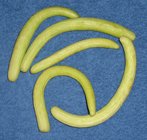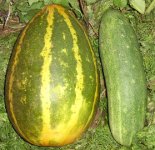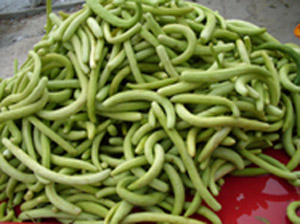Cucumber Nutrition facts
Ever wonder how to beat the scorching summer heat? Just remember your backyard, humble crunchy cucumber! Nonetheless, this wonderful low-calorie vegetable indeed has more nutrients to offer than just water and electrolytes.
It is one of the oldest cultivated crops and is believed to have originated in the northern sub-Himalayan plains of India. The plant is a creeper (vine) akin to other members of Cucurbita family such as gourds, squashes, melons, and zucchini.
Botanically; it belongs to the Cucurbitaceae family, and is known scientifically as Cucumis sativus.
 |
| Fresh Cucumbers. |
Cucumber is easy to grow. Varieties, varying in size, shape, and color, are cultivated all around the world under different climatic zones. In general, the fruit features dark green skin, crispy, moisture-rich flesh, and small edible seeds concentrated near its core.
As in other squash members, cucumbers too are best harvested young, tender, and just short of reaching maturity; at the stage when they taste sweet, have a crunchy texture, and almost neutral flavor. If left uninterrupted, the fruit continues to grow, its skin becomes tougher and turns yellow, and seeds become hard and inedible.
Fresh cucumbers are available throughout the season and can be eaten raw, in vegetable salads, or juicing.

|
 |
| Cucumis melo var. flexuosus-Armenian type. | Dosakayi-Indian curry cucumber. Salad (slicing) cucumber by side for comparison. |
Armenian cucumbers (Cucumis melo var. flexuosus) are long, crispy, thin-ribbed, curvy, and possess a light green color. Although grouped botanically in the melon family, they appear and taste just like cucumbers.
Lemon cucumbers are spherical-shaped and yellow vegetables in the Cucurbitaceae family. They do not have a lemon taste but only have the appearance in shape and color. They have thin, tender skin with a flavor a little milder than a regular cucumber.
Miniature varieties such as gherkins, American-dills, and French cornichons are tiny in size and usually preferred in pickling.
Dosakayi is a yellow Indian curry cucumber. It has a mild sweet taste and neutral flavor. It is used extensively in the preparation of stews and curries, particularly during the summer season in southern parts of India and Sri Lanka.
Health Benefits of Cucumber
It is one of the very low-calorie vegetables; provide just 12 calories per 100g. It contains no saturated fats or cholesterol. Cucumber peel is a good source of dietary fiber that helps reduce constipation and offers some protection against colon cancers by eliminating toxic compounds from the gut.
It is an excellent source of potassium, an important intracellular electrolyte. 100g of cucumber provides 136 mg of potassium but only 2 mg of sodium. Potassium is a heart "friendly" electrolyte that helps bring a reduction in total blood pressure and heart rates by countering the effects of sodium.
Cucumbers contains unique antioxidants in moderate ratios such as ß-carotene and α -carotene, vitamin-C, vitamin-A, zeaxanthin, and lutein. These compounds help act as protective scavengers against oxygen-derived free radicals and reactive oxygen species (ROS) that play a role in aging and various disease processes. Their total antioxidant strength, measured in terms of oxygen radical absorbance capacity (ORAC value), is 214 µmol TE/100g.
Cucumbers have mild diuretic properties, which are perhaps attributed to their free water, high potassium, and low sodium content. It helps in checking weight gain and high blood pressure.
They surprisingly have a significant amount of vitamin-K, providing about 7.2 µg of this vitamin per 100g. Vitamin K has been found to have a potential role in bone strength by promoting osteoblastic (bone mass-building) activity. It also has an established role in the treatment of Alzheimer's disease patients by limiting neuronal damage in their brains.
| Principle | Nutrient Value | Percent of RDA |
|---|---|---|
| Energy | 12 Kcal | <1% |
| Carbohydrates | 2.16 g | 1.6% |
| Protein | 0.59 g | 1% |
| Total Fat | 0.16 g | 0.75% |
| Cholesterol | 0 mg | 0% |
| Dietary Fiber | 0.7 g | 2% |
| Vitamins | ||
| Folates | 14 µg | 3.5% |
| Niacin | 0.037 mg | <1% |
| Pantothenic acid | 0.259 mg | 5% |
| Pyridoxine | 0.051 mg | 4% |
| Riboflavin | 0.025 mg | 2% |
| Thiamin | 0.031 mg | 2.5% |
| Vitamin A | 12 IU | <1% |
| Vitamin C | 3.2 mg | 5% |
| Vitamin E | 0.03 mg | 0% |
| Vitamin K | 7.2 µg | 6% |
| Electrolytes | ||
| Sodium | 2 mg | 0% |
| Potassium | 136 mg | 3% |
| Minerals | ||
| Calcium | 14 mg | 1.4% |
| Iron | 0.22 mg | 3.5% |
| Magnesium | 12 mg | 3% |
| Manganese | 0.079 mg | 3.5% |
| Phosphorus | 21 mg | 3% |
| Zinc | 0.17 mg | 1.5% |
| Phyto-nutrients | ||
| Carotene-ß | 31 µg | -- |
| Crypto-xanthin-ß | 18 µg | -- |
| Lutein-zeaxanthin | 16 µg | -- |
Selection and storage
 |
| Armenian type-cucumbers in a market. |
Cucumbers can be sold readily in the local markets all around the season. Fresh varieties, depending upon the cultivar type and region, as well as preserved, pre-processed, and pickled are also made available in the grocery stores.
In the stores, buy fresh ones that feature a bright green color, firm, and stout in texture. Look for spots, cuts, or breaks on its surface. Do not buy overly mature or yellow-colored cucumbers since they tend to possess tough skin, and mature (hard), inedible seeds. Furthermore, avoid those with wrinkled ends as they indicate old stock and out of flavor. Go for organically grown products to get the rich flavor and nutrient content.
Once at home, they should be washed thoroughly in clean water to rid of any surface dirt and pesticide residues. Their skin comes in a variety of colors and often with tiny spikes that should be rubbed off easily. Do not discard the peel as it has vital minerals, phytochemicals, and fiber.
To store, keep them at room temperature for a day or two, but better stored in the refrigerator set at high relative humidity where they stay fresh for several days.
Preparation and serving methods
Wash them thoroughly in cold running water just before use. Scrub gently at places where prickles or dirt are attached firmly. Trim both ends using a sharp knife and rub the ends to remove the sticky, off-white, fluid-like oozing substance in order to lessen the bitter taste at either end. Cut into cubes, or slices, as you may desire.
Here are some serving tips:
Fresh, cleaned cucumbers may be enjoyed as they are without any additions.
Its cubes/slices are a great addition to vegetable/fruit salads.
Indian yellow curry-cucumber (dosakayi) is used widely in a variety of curry, and stew preparations in South India with added buttermilk and yogurt.
Finely chopped fresh slices mixed with yogurt, cumin, coriander, pepper, and salt to make Indian condiment, cucumber raita.
Cucumber juice is a very good health drink.
Fine slices also added in delicious Spanish cold tomato and cucumber soup, gazpacho.
Gherkins and thick rinds of other varieties have been also used in the preparation of pickling.
Safety profile
Often, some cucumbers mat turn bitter akin to bottle gourds due to terpenoid toxic compounds such as cucurbitacin B, D, G, H, etc.
A small slice of cucumber should be tasted before eating the whole fruit to ensure that it is not bitter. If found; the whole fruit should be discarded. In case of discomfort after consumption (nausea, vomiting, diarrhea, or any feeling of uneasiness), the person should be immediately taken to any nearby hospital. (Medical disclaimer).
Also read ≻≻-
≻≻- Dill pickle (pickled cucumbers) nutrition facts.
≻≻-Back to Vegetables from Cucumber nutrition. Visit here for an impressive list of vegetables with complete illustrations of their nutrition facts and health benefits.
≻≻-Back to Home page.
Further Resources:
Stanford School of Medicine Cancer information Page- Nutrition to Reduce Cancer Risk.
.